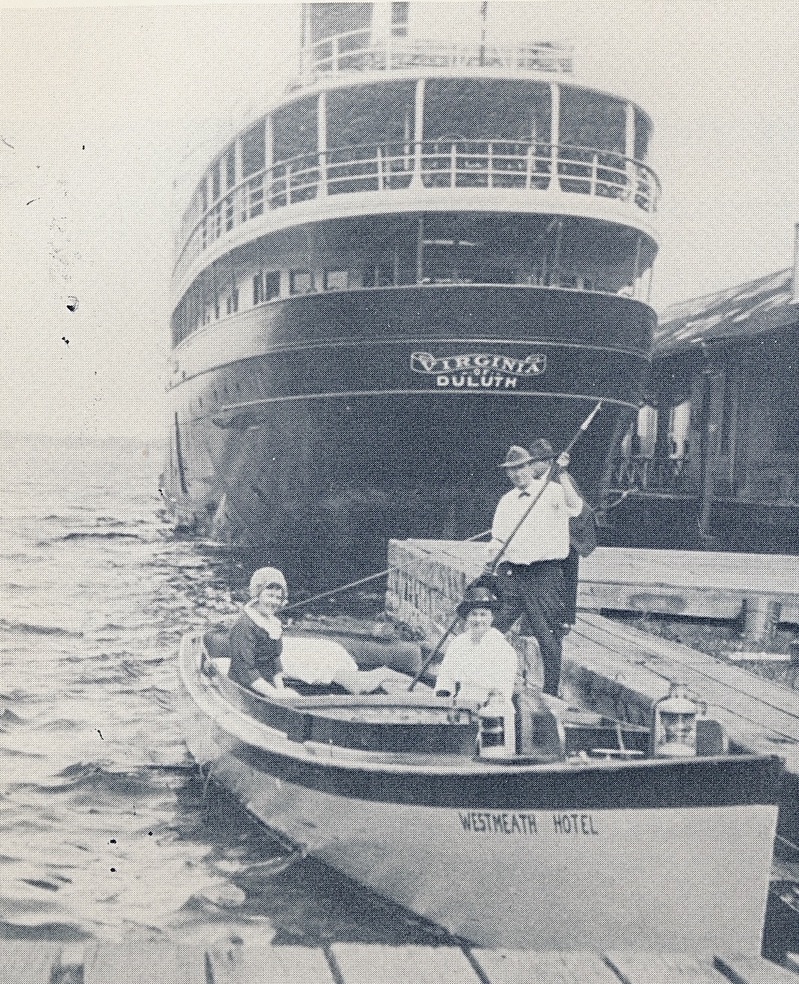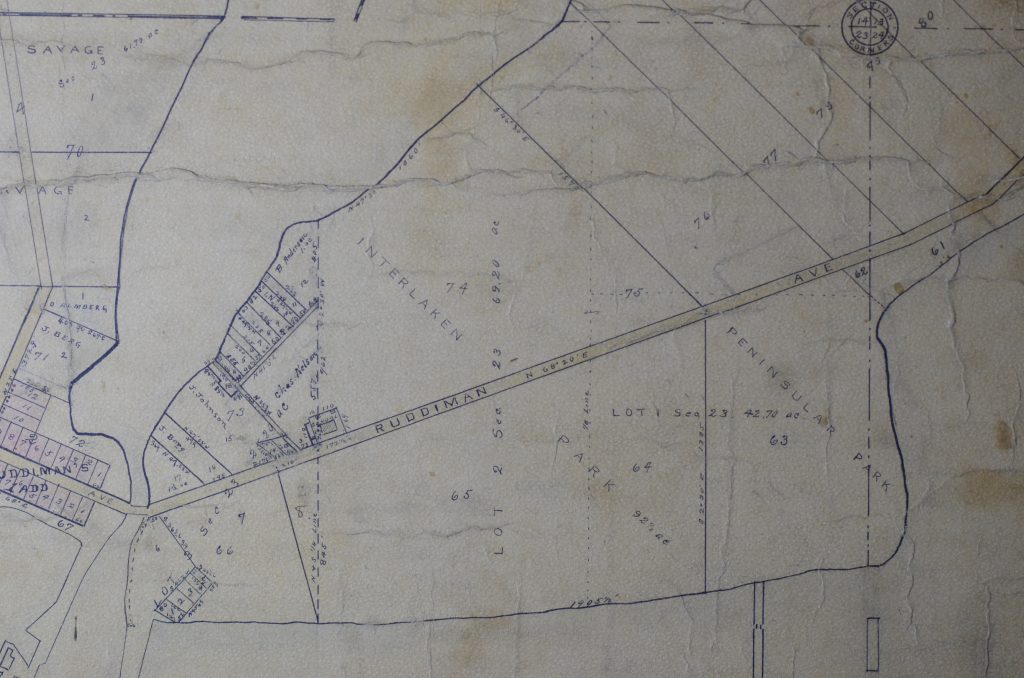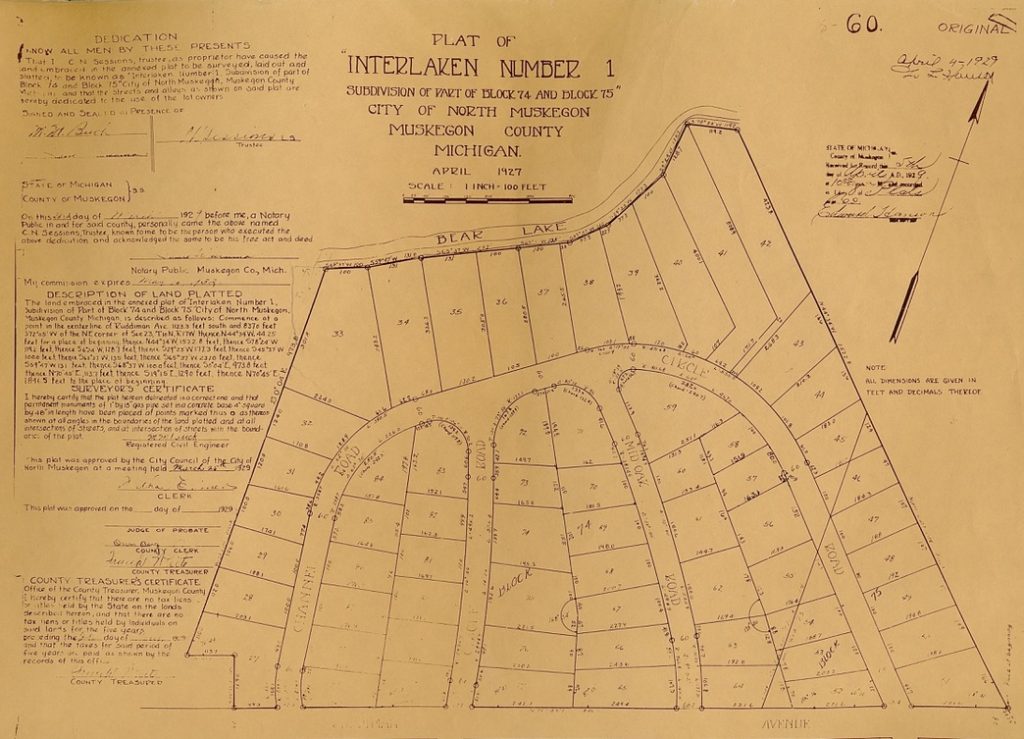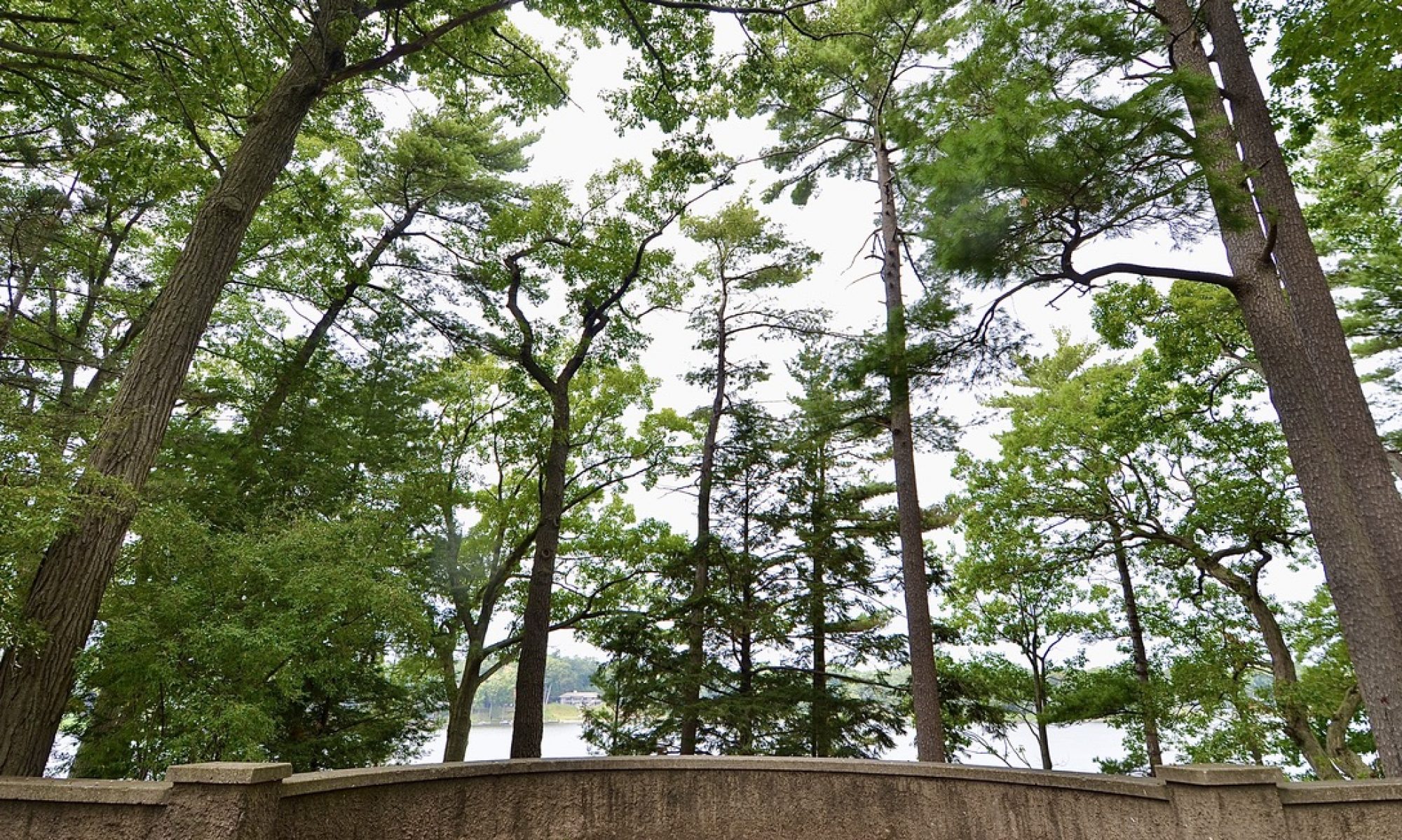“Interlake Park” they have named it. Looking out as we may upon its surroundings, with Muskegon lake upon the south, Bear lake upon the north, with a broad open, inland sea-lacking only the saline properties-that grand body of water, Lake Michigan, on the west, we might well call it the park of the lakes-the park of the peninsulas. – MAJOR C. DAVIS – Pioneer Picnic August 30, 1887
Human occupation of the Muskegon area goes back seven or eight thousand years to the nomadic Paleo-Indian hunters who occupied the area. They were superseded by several stages of Woodland Indian developments, the most notable of whom were the Hopewellian type-tradition, which occupied this area, perhaps two thousand years ago.
During historic times, Muskegon was inhabited by various bands of the Odawa (Ottawa) and Pottawatomi Indian tribes, but by 1830 Interlaken and the surrounding area was occupied on and off by Ottawa Indians. Their name for lakes that surround our peninsula, Bear Lake was said to be Moqua or Makwa – meaning Black Bear – and Muskegon or “Masquigon” meaning “marshy river”. In recorded times, the closest Native American camp to Interlaken was at Green Creek. Although impossible to definitively calculate, it stands to reason that as many as 200-300 Ottawa may have lived in and around the Bear Lake channel. We know that similar geography of the area such as the Muskegon Lake channel had as many as 500 living on each side. Muskegon lake was a prime fishing area for the Ottawa, and the Muskegon river delta had what may have been the best source of wild rice “manoomin” found on the this side of Lake Michigan.
Although there were other Europeans that explored and mapped our area in the latter part of the 18 century, It is widely accepted that Jean Baptiste Recollet, a fur trader from Canada was the first European to settle in North Muskegon, on the West side of the Bear Lake channel in 1812.
About 25 years after this first settlement in 1837, Jonathan Ford an agent for Buffalo and Black Rock Co. built a dam and water mill for cutting lumber at the Bear Lake channel. Michigan was still considered the West at that time and it was essentially a wilderness. There was very little settlement and these people were considered “pioneers”. In 1839 it appears that property “came on the market” from the government and could be purchased. On August 10, 1841 Johnathan H. Ford purchased 122 acres including the Interlaken property from the United States government and became the original “owner” of the what are now the Interlaken properties. . Local lumber barons had the opportunity to buy land for as little as $1.25 per acre. The whole 93 acres might have cost around 120 dollars – approximately $3,800 in 2020 dollars.
George Ruddiman came to America in 1833 from Scotland. He settled in Muskegon in April, 1840, and engaged as a millwright in repairing the mill at the mouth of Bear lake that Jonathan Ford had built. In 1841 he took charge of this mill, and in 1844, his brother, John Ruddiman joined him. At this time the Ruddimans were the only Europeans on this side of the lake. The area was still primarily occupied by native Americans. At some point during this time John Ruddiman obtained the property from Johnathan Ford.
Mrs. Mary A Collins an early pioneer, arrived North Muskegon in 1856, during the time when John Ruddiman his wife and two daughters were the only Europeans in North Muskegon. Interviewed later in life she recounted the following. “The deer and wild hogs used to run around then as plentiful as dogs now. The deer were very tame because they were never shot at. Bear Lake which is so famed for its bathing now was so full of fish that a person wouldn’t dare to step into the waters for fear of being eaten alive. Wild hogs would come up to the house at night looking for food. I will never forget the time the wild pigeons first came. They would darken the sun so that it would be like twilight for hours at a time. Because of their numbers they were most ruthlessly destroyed”. “The wild ducks were so think on Muskegon lake at that time” says Mrs. Collins “ that the boat has to push an opening in the flocks”
For the next thirty or forty years the lumber era gained a foothold and grew with as many as 47 mills surrounding Muskegon Lake. During this time the Interlaken Property was pretty much dormant – The East end of North Muskegon was platted and grew during this period. Originally called Reedsville, North Muskegon incorporated as a village on March 18, 1881. Below you can see that North Muskegon has been divided up, but the Interlaken Property remains in one piece.

In June 1883 the dam across the channel was washed away after the level of Bear Lake had risen four feet after unusually heavy rains which lasted three days. The lake had been a favorite spot for rowboat races and a regatta had been scheduled at the time of the flood.
In 1885 the Interlaken Park was seriously considered as the site for the Michigan Soldier’s Home, (a home for disabled Michigan veterans from the Civil War) but ultimately the State was not interested and instead built the home in Grand Rapids in 1886 on Monroe St.
In 1886 the Muskegon, Grand Rapids, and Indiana Railroad bought Interlake Park. In conjunction with the main road being built in North Muskegon, they planned to “develop it into a popular resort to be used in connection with the railway for excursions and steady travel for summer visitors” (Chronicle Oct 18 1906) Muskegon Illustrated wrote around this time “Recently purchased by M.G.R. & I.R.R. for summer resort purposes. This commands a lovely view of both lakes and has been cleared and otherwise improved. In it a large and artistically designed gothic pavilion nearly one hundred feet long has already been built and workmen are now preparing to erect boat houses, bath houses, and a commodious wharf with other needed conveniences. It is the purpose of the company to erect a handsome hotel and cottages in another year and make this one of the most attractive places upon the lakes for summer tourists.”

They Owned the property for about 20 years and during that time the railroad allowed it to be used essentially as a public park. The park was very popular with locals and visitors to Muskegon. The book “Proud Peninsula” states, “It was possible to board the evening steamer in Chicago or Milwaukee at night and wake up in the morning at its door, after a night of refreshing sleep on Lake Michigan. There was no long wait or transfer or ride by trolley or train. A launch was at hand and in less than six hours city travelers were in North Muskegon”.

On August 30, 1887 the Muskegon County Pioneer Society had the first of several large gatherings at Interlaken Park. They were celebrating the semi-centennial of the founding of Muskegon and 75th anniversary of the first settlement in Muskegon. The picnic was attended by between 5000 and 7000 people. The attendees had to get across Muskegon lake by Tug or by scows towed by tugs. At the picnic Austin Blair, Michigan’s Governor was scheduled to speak as were 24 other local residence of the “pioneering type”. Speeches and music were heard throughout the day. Many of the speakers were older pioneers who had lived in North Muskegon or the surrounding area and told their stories of living in the wild. For years afterwards, Interlaken Park was used as the most popular picnic grounds of the towns people. Below is the program for the picnic in 1887.

On May 7, 1889, the Interlake Park Association was established with one Mr. Conner as the group’s first president. Interlake Park, continued to be a very popular picnic ground. Twin ferry boats on Muskegon Lake carried to and from the park. Fishing gear and boats were available, as were swings and hammocks. Ferry boat lines advertised excursions and picnics at Interlake Park, as well as baseball games and dancing. In 1888 a baseball diamond was set up in the park. A large stand built from rough lumber seated some 300 spectators. A large fence enclosed the grounds and the first game was played on July 4, 1888. Hopes were that big league teams from Detroit and Chicago would play summer games there. On the contrary, almost all of the games played there were local in nature.


On October 28th 1902 The Muskegon Chamber of Commerce escorted Rear Admiral H. C. Taylor and his entourage to a tour of Interlake Park as a proposed site for a US Naval training station. Although Taylor said “it was a great pleasure for me to visit Muskegon” our land must not have fit the bill and the plans never materialized.

On October 18th 1906 J.E. Montgomery and Daniel Christie bought Interlaken Park from M.G.R & Railroad. The new parks owner divided the land into lots for summer resorts and or permanent homes. Their goal was to attract a large hotel operator and platting the land into lots for cottages. A common piece of land on both lakes was to be reserved for all to use and common access around the entire property was planned. The demand for resort property had been growing and the lots were expected to sell quickly.
By 1907 the Chronicle reported that the undergrowth had been cut away from all 95 acres and divided into 368 lots and street signs were put up. An office building was built and stairs on the Muskegon lake side bluff. The undergrowth was cut and trees trimmed of low dead branches. An eight-foot-high, forty-foot-long sign was placed at the highest point on the Wester bluff on Muskegon lake where the name of the park was announced. A 2000-foot breakwater was added as was a pier and steps up the bluff. A Kindergarten was planned for the corner of Channel and Ruddiman on the West corner. It had been expressly required as part of the founding of the association. The specific reason for its ultimate abandonment is unknown. The space is vacant to this day.

The resort business flourished until the 1920s when Muskegon’s Big Three – L.C. Walker, president of Shaw-Walker Co.; E.H. Sheldon, president and founder of E.H. Sheldon & Co.; and Louis Lunsford, secretary and treasurer of the Amazon Knitting Co. – launched a drive to convert the resort properties into the area’s swankiest subdivision.

E.H. Sheldon was the first residence built in the new association. Within five years North Muskegon was home to the Vue de L’Eau Roque Club and the only roque (a mid-century blend of croquet and billiards) court in the western half of the state.

On June 10, 1929 The Interlaken Association was registered as a non-profit corporation. Any cottages that existed at this time appear to have been moved or demolished. The subdivision and association were advertised . One brochure stated ” 100 acres of beautiful lawns and gardens with sufficient trees fully grown and matured to furnish shade and adornment. Stone roads wind in and out of the property”. Today the Interlaken Association is a homeowner’s association that still occupies the same 93 acres, as it did back in the 1830’s and has 78 homes in the association and operates under virtually the same By-Laws and Covenants that were established back in the 1920’s.

